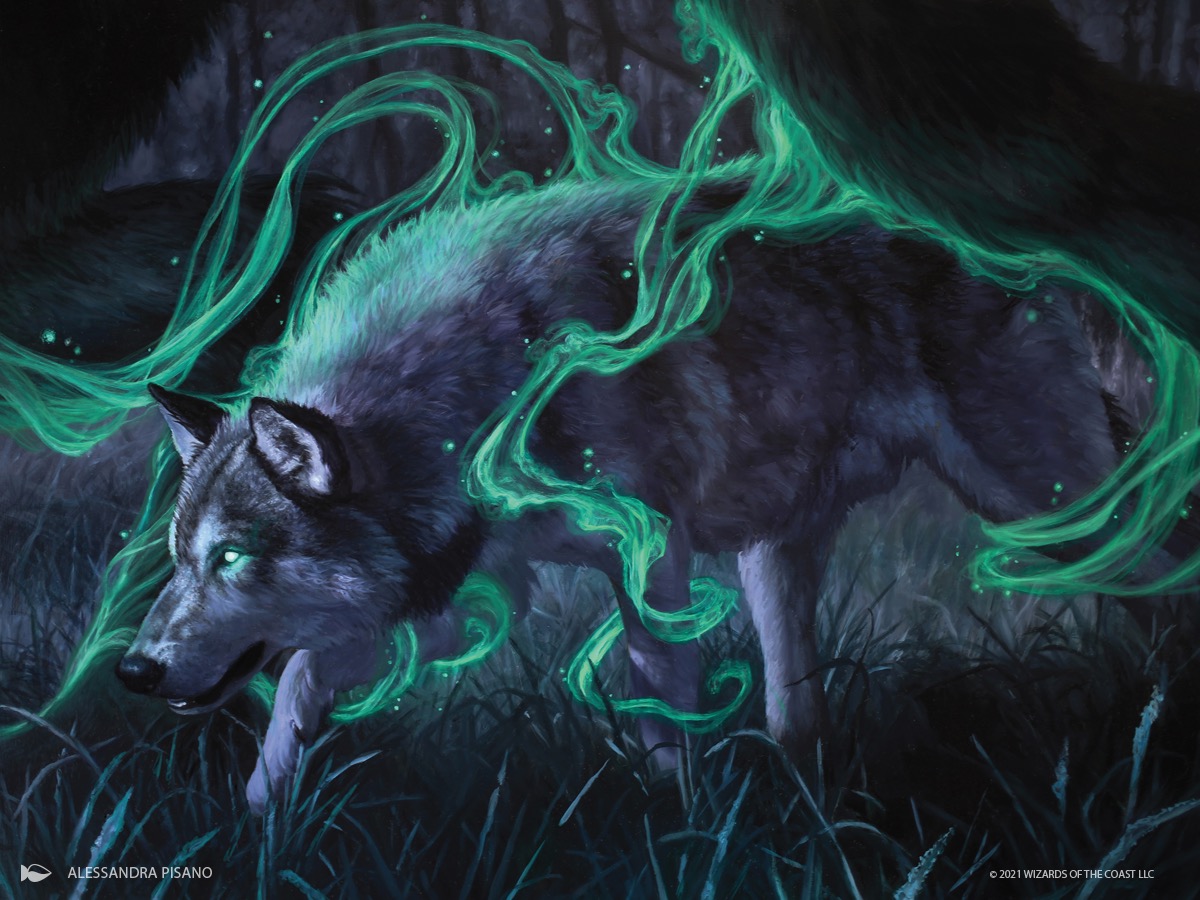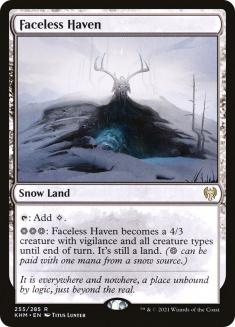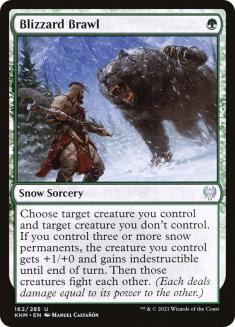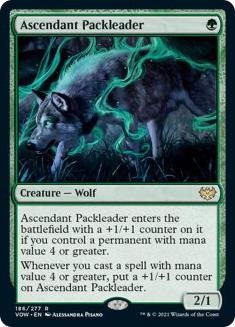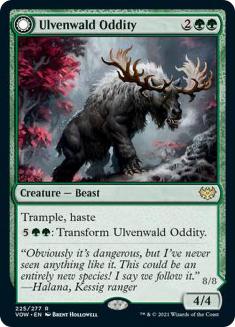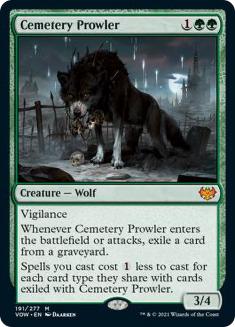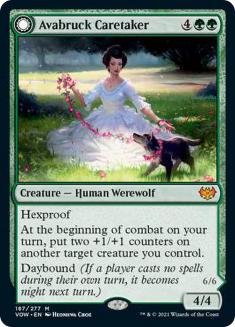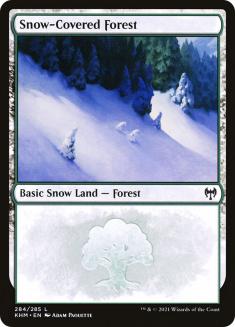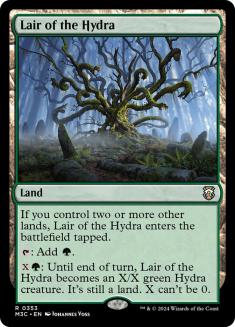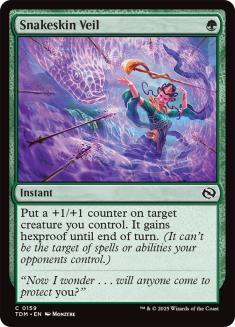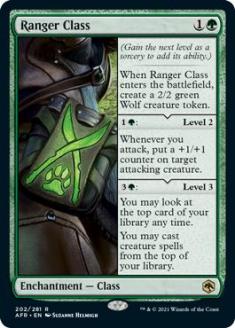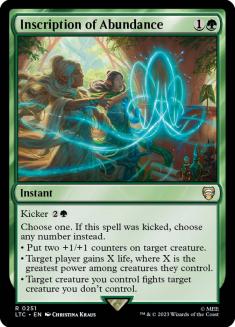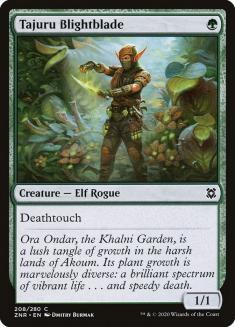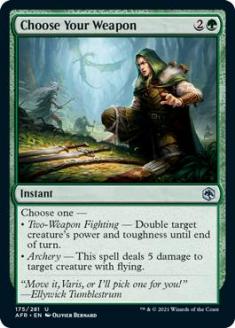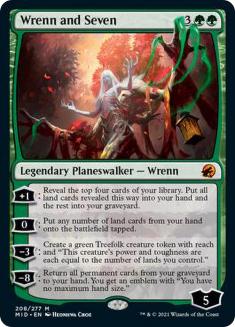Recently, I mentioned how I thought Innistrad: Crimson Vow was more about powering up existing decks rather than creating entirely new ones. The three decks perceived as the best, Izzet Epiphany, Mono-Green Aggro❄, and Mono-White Aggro❄, all got meaningful upgrades, which meant they were likely to remain Tier 1 even after the new set. Last week I talked about Mono-White Aggro❄. Today I’m going to talk about Mono-Green Aggro❄.
We don’t have a whole lot of data about Innistrad: Crimson Vow Standard. It’s still quite new and will likely only settle after the Innistrad Championship at the start of December, but there have been some tournaments that we can draw information from, and Mono-Green Aggro❄ has done pretty well in those. For reference, here’s the list from Matheus Yakio Yanagiura, who finished in second place in the Silver division of the RedBull Untapped 2021 tournament with a list that I believe is very close to optimal:
Creatures (25)
- 2 Lotus Cobra
- 4 Kazandu Mammoth
- 4 Old-Growth Troll
- 4 Sculptor of Winter
- 4 Werewolf Pack Leader
- 3 Ulvenwald Oddity
- 4 Ascendant Packleader
Lands (23)
Spells (12)

Mono-Green Aggro❄ is a beatdown deck through and through, but it’s more of a “midrange beatdown” rather than super-aggro like Mono-White Aggro❄. You’re more of a quality over quantity kind of deck and you’re trying to curve out. There are arguments for playing other colors alongside a green base, but the biggest selling point for Mono-Green specifically is that it enables the snow cards — Faceless Haven and Blizzard Brawl.
Faceless Haven is the most powerful creature-land around, and being able to play it is a big upgrade over Lair of the Hydra and similar lands, but Blizzard Brawl is the main reason to be Mono-Green. The card is just way more powerful than it looks. Costing one mana means you can often double-spell with it, which is important because you often fall behind early on, and the indestructibility allows you to attack with a creature that might not ordinarily be able to, such as an Esika’s Chariot in a crowded battlefield. The card really, really overperforms compared to expectation and is a strong draw towards this deck in particular as opposed to other green-based aggro decks.
There aren’t that many cards from Innistrad: Crimson Vow that impact Mono-Green, but the cards that do make an appearance are much more important than they might seem at first glance.
Ascendant Packleader is not a very flashy card, but it’s honestly hard to overstate how much Mono-Green was lacking a good one-drop. The biggest problem with the deck was that it was clunky, which meant decks like Mono-White Aggro❄ could go under you, and sometimes decks like Izzet Epiphany would use bounce spells like Fading Hope and Divide by Zero to keep the battlefield clean and buy a lot of time. Now that you have a one-drop, it’s much harder to do this.
Mono-Green Aggro❄ usually casts one spell per turn, and it follows a relatively strict mana curve — you’re going to cast a two-drop on Turn 2, a three-drop on Turn 3, and a four-drop on Turn 4. This means that, if you have a redundant two-drop, it’s usually not getting cast until Turn 5 or even later.
If that two-drop is a one-drop instead, however, it’s going to be cast Turn 1 and it’s going to be on the battlefield for four more turns than your second two-drop would be, which means it gets to deal eight or ten damage more just by virtue of costing one mana instead of two. So, even though it looks like a small upgrade, and the card is itself not that good (there aren’t that many ways to power it up), it’s a deceivingly big change in how the deck can fundamentally operate and I believe it will make a big difference.
Ulvenwald Oddity didn’t make a great first impression when people looked at it during preview season, but I think that’s mostly because we were spoiled by Questing Beast. A 4/4 creature with trample and haste for four mana is definitely passable (we were playing Froghemoth at Magic World Championship XXVII to get a similar effect for one more mana), and in this deck it’s not that hard to transform it, at which point it will dominate the game, especially in mirror matches.
In that same event, we played a copy of Primal Adversary as a trampling threat versus the black decks and a haste threat versus sweepers. Ulvenwald Oddity is arguably better at performing both of these jobs, and it’s a better mana sink to boot, so this makes it an easy replacement at least.
Cemetery Prowler does a bunch of things — it’s a solid body, it has vigilance, it’s graveyard hate, and it makes your cards cost less — but the problem is that none of these things are things you actually want to do. As a body, it’s outclassed by both Old-Growth Troll and Kazandu Mammoth, and while the exiling effect might come up from time to time, it’s not enough to be a big selling point. For this card to shine, you want to be using the discount effect, but I just don’t think you will most of the time. The most likely scenario is that they kill one of your creatures and then you cast this and your next creature costs one less, or you cast it and Blizzard Brawl one of their creatures, but in the end it’s just not that easy to get a discount that actually matters.
All in all, I think the other three-mana cards that we’re already playing are simply better, and I don’t think I’m interested in more three-drops. If I were, I’d maybe even play Briarbridge Tracker over Cemetery Prowler. If I’m going to play Prowler, it’ll be a sideboard card specifically because I want to exile my opponent’s graveyard.
Avabruck Caretaker is the ultimate stall-breaker, as it will completely and utterly dominate any battlefield if you’re not being pressured. If the game is even-ish, then this card will likely win it on the spot, but if you’re losing badly, it might not be good enough to help you. Tovolar’s Huntmaster played a similar role, but it did a better job at stabilizing the battlefield and a worse job of closing the game out, so which of those you play will depend on which type of effect you’re looking for. Personally I think I’m more into the “win the stalled game” aspect of it, so I think Avabruck Caretaker is the better choice of six-drop.
This is basically it for potential Innistrad: Crimson Vow inclusions, but, again, I believe they make a meaningful difference. Now let’s talk a bit about some of the contentious choices from this build.
One thing that I believe is constant among almost every single Mono-Green list I see these days is that they don’t have enough lands. At Magic World Championship XXVII, we played 29 lands, counting four Kazandu Mammoth and two Tangled Florahedron; Matheus is actually playing 27 lands with two Lotus Cobras, which is a similar amount, but that’s definitely the high end of what I’ve seen. It’s not uncommon to see lists with as few as 24 lands total!
Even though Mono-Green Aggro❄ is an aggressive deck, it uses extra mana extremely well. It has creature-lands, Ranger Class, modal DFCs (playing Kazandu Mammoth as your three-drop is quite good and then you want extra lands on top of that to pump it), Werewolf Pack Leader activations, Inscription of Abundance, Old-Growth Troll turning lands into creatures, and now Ulvenwald Oddity as an extra mana sink. It’s much more common to lose a game because you don’t have enough lands than it is to lose because you flood out.
Back then, the deck didn’t have any one-drops, so playing Tangled Florahedron was sort of free, and I thought they were better than Lair of the Hydra. Nowadays, with Ascendant Packleader, things have changed, and playing a tapped land on Turn 1 is a real cost. Kazandu Mammoth is very strong, so I think you still play that (again, you’re mostly looking to use it as a creature anyway), but Tangled Florahedron is no longer good enough and I think cutting it for Lotus Cobra makes sense, though I would just play an extra land.
Speaking of extra land, Matheus played three Faceless Havens and I’ve seen people who play as few as two. I believe the card is just too good not to play four copies of, even if it clashes with Old-Growth Troll some of the time.
This is my current list:
Creatures (23)
- 1 Lotus Cobra
- 4 Kazandu Mammoth
- 4 Old-Growth Troll
- 3 Sculptor of Winter
- 4 Werewolf Pack Leader
- 3 Ulvenwald Oddity
- 4 Ascendant Packleader
Lands (24)
Spells (13)

The three Sculptor of Winter, one Lotus Cobra split might be weird, but Sculptor of Winter is worse versus bounce and worse in multiples, so I think this is a reasonable approach.
The biggest decision to make when building this deck is whether you want to play more Snakeskin Veils or Inscription of Abundances in the maindeck. I believe you’re going to want to have access to four of each after sideboarding for sure, but how many start in your maindeck is completely metagame-dependent and I could see basically any combination that added up to two to four of them. Right now, I think Snakeskin Veil is more important (the deck is more aggressive than it was before, so it’s harder for people to play around it), but this could change at any time.
I consider Mono-Green Aggro❄ to be relatively even versus both Mono-White Aggro❄ and Izzet Epiphany. In fact, these three decks are mostly even among themselves and favored versus the aggregate of the rest of the field, which is why I think they make up Tier 1.
VS Mono-White Aggro❄
Mono-White Aggro❄ can slant their build to beat you, but I don’t think they should do that right now. In fact, their changes might make them worse against you, as Valorous Stance is not as good as Fateful Absence, and Thalia, Guardian of Thraben is not hugely problematic. The most important cards on your side are the fight spells, and Fateful Absence was very good at breaking those up, but it’s much easier to play around Valorous Stance (just target a smaller creature, which is okay because Blizzard Brawl gives indestructible anyway). They still get to save their creature, of course, but you don’t get blown out by it.
Winning the die roll is super-important in this matchup, and whoever is on the play is heavily favored, particularly if they have Reidane, God of the Worthy. If the white deck is on the play and has a fast start, you really need multiple Blizzard Brawls to catch up or you’re just not going to win (though at least now you have a one-drop that can block, so there’s that).
Out:
In:
After sideboarding, things tend to improve for you, though again it depends on how their build is configured. If they have a lot of sideboard for you then your fight spells will not be able to match up. Overall, though, you get to lower your curve a little bit and you get more removal for their Brutal Cathars and Skyclave Apparitions, so that’s good.
VS Izzet Epiphany
Being on the play is also very important here (that’s a constant with this deck), and again this match can range from slightly favorable to slightly unfavorable depending on how they construct their deck. The good news is that, much like the matchup from Mono-White’s perspective, the cards they want versus you are not the cards they want versus the other Tier 1 decks. Mono-White is also a creature deck, so it stands to reason that whatever is good versus them is good versus you, yet that’s not necessarily true. Versus Mono-White you’re really looking to have sweepers such as Cinderclasm and Burn Down the House, but versus Mono-Green you might be more interested in bounce spells and one-for-one removal such as Demon Bolt.
Out:
In:
Sideboarding here can depend on what they are playing. Most people will have some number of Dragons (either Smoldering Egg or Goldspan Dragon), so I like Choose Your Weapon (I think it’s better than Tangletrap because it’s not useless if they don’t have a Dragon out), but if they have Cyclone Summoners and Lier, Disciple of the Drowned instead, then you can feel free to either shave Inscriptions or include Blizzard Brawl. If they try to go super-grindy with one-for-one removal, Ranger Class will be good as well, but most people don’t have this approach versus Mono-Green Aggro❄.
VS Mono-Green Aggro❄
The mirror is not so different from a normal aggro or midrange mirror, and whoever develops an advantage usually keeps it until the end of the game. On the draw, you have to be more reactive and try not to die, and on the play you’re just applying as much pressure as possible. Blizzard Brawl and Esika’s Chariot are the best cards here.
Out:
In:
After sideboarding, I like having access to a couple of copies of Wrenn and Seven. It’s not good versus a lot of the rest of the field (it’s too easy for white to tax it and for blue to counter/bounce it), but in Mono-Green mirrors it can be very powerful, especially in combination with Esika’s Chariot and to a lesser extent Ulvenwald Oddity (since it finds you lands to transform the Oddity and then the Oddity gives the tokens trample). I think Avabruck Caretaker is certainly more powerful, but Wrenn and Seven is cheaper and does a much better job of stabilizing. That said, it’s possible that after playing with Avabruck Caretaker more I’ll want to move to two copies.
The rest of the sideboard is honestly pretty flexible. Ranger Class can come in versus grindy decks and Outland Liberator is a catch-all versus decks with stuff like The Celestus or white versions with a ton of Portable Holes, but the reality is that they’re there mostly because there’s nothing else I truly want.
Overall, Mono-Green Aggro❄ didn’t get that many cards, and certainly nothing as flashy as Thalia or Valorous Stance, but the impact of the new cards in Mono-Green is much bigger than it seems at first glance, so I believe this will remain a Tier 1 deck that you should not ignore.
If you want to play an aggro deck, this is the one choice that competes with Mono-White Aggro❄ at this point.

